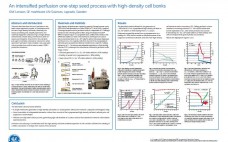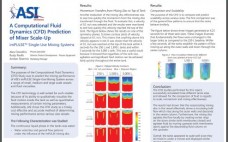Temperature control during sourcing, manufacturing, and delivery of cell therapies is crucial, as fluctuations can affect viability and function of the cells, and potentially, the overall efficacy and safety of the therapeutic product. In many cell therapy workflows, source cells arrive cryopreserved at LN2 temperatures (-150 to -196 °C) and post-manufacturing, cells are again cryopreserved and stored in vapor- or liquid phase LN2 prior to their use in the clinic. In either case, containers filled with dry ice (-50 to…
Upstream Processing
Efficient Optimization of CHO Cell Culture Medium and Feed for Increased Antibody Production
Traditional medium optimization strategies are labor intensive, costly, and time consuming. In this project, high-throughput screening technology was adopted along with statistical design to reduce costs and decrease time for optimizing culture conditions for maximized antibody production from a custom Chinese hamster ovary (CHO) cell clone. The presented work includes two phases: phase 1 for basal medium optimization and phase 2 for feed optimization. Phase 1 and phase 2 each have two rounds. A DoE screening methodology was used to…
An Intensified Perfusion One-Step Process with High-Density Cell Banks
Seed culture expansion is commonly performed in several consecutive batch cultures. Starting from a cryopreserved cell stock, the initial culture expansion is typically performed in shake flasks, while the final steps are performed, at greater scales, in bioreactor vessels. Such a procedure is time-consuming and labor intensive with multiple steps that introduce risk for mishandling and contamination. This work describes how the use of perfusion in the seed culture expansion process, in combination with the use of high-density cell banks,…
Development and Optimization of CHOgro® Transient Expression Technologies for High Titer Antibody Production in Suspension CHO Cells
During early stage drug development, quickly obtaining relevant candidate proteins through transient transfection can accelerate drug dis-covery. High titers are often obtained from Human Embryonic Kidney (HEK) 293 derived cell types; however, the use of different host cells between early stage transient and later stable protein production is a concern and can lead to the advancement of false-positive candidates. Chinese hamster ovary (CHO) cells are a desirable target cell type due to growth characteristics and a history of regulatory approval;…
Development of a Novel Cold Chain Tubing, FP-FLEX™, and Single- Use Freezing Bag for Working Cell Banks Enabling Closed-System Processing to Temperatures as Low as -196°C
Working cell banks (WCB’s) are commonly applied to initiate cell culture manufacturing campaigns for production of therapeutic proteins. These campaigns typically begin with inoculation of cells previously cryopreserved in vials. While vials are typically used to establish WCB’s and initiate manufacturing campaigns, they are not optimal for the growing demands of commercial production. Vials are small and filling/removal is performed through an open cap. This process leads to numerous manual operations and culture vessels, resulting in contamination risks and potential…
A Computational Fluid Dynamics (CFD) Prediction of Mixer Scale-Up: imPULSE™ Single-Use Mixing Systems
ASI-Life Sciences commissioned a CFD study of our imPULSE single-use mixing systems to predict and characterize the mixing performance of the systems across small, medium and large vessels and fluid viscosities. One characterization from the study as you will see in Figure 1 of the poster was the rate at which the momentum from the mixing disc transferred through the fluid. As you can see in the Figure within 5 seconds, fluid motion was achieved in the 250 L, 1,500…
Adopting a Fully Single-Use Process to Improve Speed to Clinic: A Leachables Case Study
The implementation of single-use technologies for pharmaceutical product development continues to gain momentum; this trend is due to the advantages of increased flexibility, speed of implementation and lower capital investment. In particular, they are seen as a means to accelerate the production of material for clinical trials. However, a primary concern regarding the use of such technologies is the impact and level of leachables in the final drug substance. Typically this concern is addressed through a risk assessment utilizing extractable…
Freeze-Pak™ STS Bio-Containers and STS Shippers: A New Single-Use Solution for Frozen Storage & Transport to -80°C
Frozen storage is commonly performed and enables manufacturing process flexibility, long-term product stability and minimizes logistics challenges. While single-use containers are available for storage and transport of frozen products, some require a significant investment while others don’t offer the necessary support and protection. Using films and bags not designed for frozen storage applications can be detrimental.  Charter Medical recently developed a new family of single-use frozen storage and transport solutions. The Freeze-Pakâ„¢ STS (FP-STS) bio-containers and supporting secondary single-use…
Optimization of HEK 293 and CHO-S Cell Growth by Supplementation of Non-Animal Derived Components Using Design of Experiments (DoE)
Mammalian cells are a widely used expression platform for the production of recombinant therapeutic proteins or viral particle-based vaccines since they typically perform appropriate protein post-translational modifications and authentic viral particle assembly. Of the available mammalian cells, CHO and HEK 293 are some of the most industrially relevant cell lines because they are cGMP compliant and are able to grow in suspension in a variety of serum-free media. Of note, production of human therapeutics in mammalian cell culture has become…
Optimization of the Rocking Speed and Angle of a Perfusion Bioreactor for T Cell Culture
For autologous T cell therapy to be effective, T cells sampled from a patient need to be grown in sufficient quantity before being injected back. The typical cell number required for an 80 kg patient is 8.109 cells. Achieving such a dose with T flasks, while maintaining cell health, poses logistical challenges that can become intractable when the number of patients rises. This is why the Xuriâ„¢ Cell expansion system W5, a rocking platform which enables automated high cell density…










